The Freer-Sackler Galleries in Washington have a new exhibition displaying of some of the most beautiful and significant calligraphy and book illustration ever produced. Each exhibit is the same product, yet there is no sense of repetition. What could this be? It is the Qur’an, Islam’s holy book containing the Prophet’s message. To be precise there are 61 Qur’ans, or parts of Qur’ans, which span the 8th to the 17th centuries in time and encompass the Middle East in space. In today’s global confusion over the explanations and interpretations of Islam, whose essence is the Qur’an, this makes the show timely and important. It should be a crowd-puller, for it sets right so many common misunderstandings about the Qur’an. Indeed, as many people as possible should go to Washington to see it or – almost as good – go to the exemplary online companion to the show, which has been available from the day it opened (if only all museums would copy this effort).
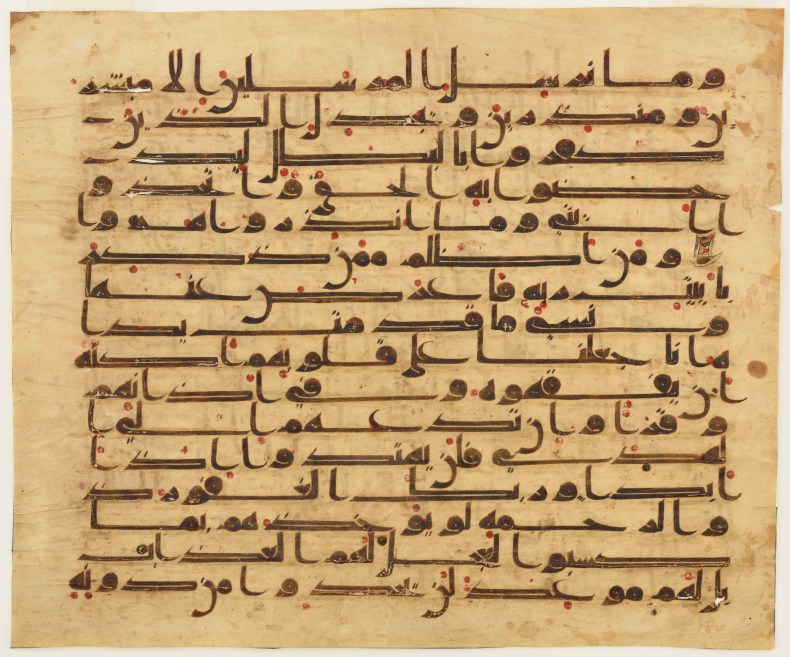
Folio from a Qur’an, Iran or Iraq, Abbasid period, end of 8th century.
But, first, a word about the loan itself. Forty-seven of these Qur’ans belong to the Museum of Turkish and Islamic Arts in Istanbul; the Freer-Sackler owns the rest. The Istanbul museum was founded in 1914 to receive and keep safe the staggering riches scattered across the Ottoman Empire since the 16th century. Such was the quantity that – to take just one type of the books alone, and from just one building – more than 3,000 Qur’ans and 250,000 Qur’anic fragments came from the Umayyad Mosque in Damascus. While there is an inventory of each piece’s arrival, and from where, a century later much remains to be catalogued or put on public display. The loan deal is almost as remarkable, sealed by Freer-Sackler curator Massumeh Farhad and director Julian Raby: this is the first time most of the exhibits have been outside Turkey, and they are some of the greatest treasures of the collection. Many of the pieces have never been seen even by dedicated specialists.
The show sets out to address common questions. What is the Qur’an? The word of God received by the Prophet through the Archangel Gabriel, recited orally and then written down – but to be read aloud; the word qur’an means ‘recite’ or ‘read’. Why are its script and decoration arranged as they are? Above all, to aid recitation and to define each sura (chapter) or juz – a thirtieth of the Qur’an, so a complete reading can be achieved in a lunar month. Why is it important? Its contents set out the core life guide for Muslims, and the show takes up four themes from it including revelations of the early prophets up to Muhammed and parameters for community life, from weddings to looking after orphans. And what do these Qur’ans tell us about the history of the Middle East? So esteemed was the Qur’an that patrons commissioned top court artists and calligraphers to create them as lavish gifts to mosques, tombs, institutions, and fellow rulers across the greater Islamic world. Many were made in cities that today conjure up destruction and suffering, but were for centuries sophisticated international centres of learning – the show has Qur’ans from Mosel, Damascus, Sanaa, Baghdad. Throughout, there are reminders that Muslims share with Jews and Christians the unbroken sequence of the prophets of the Jewish Tawrat (Torah) or Old Testament.
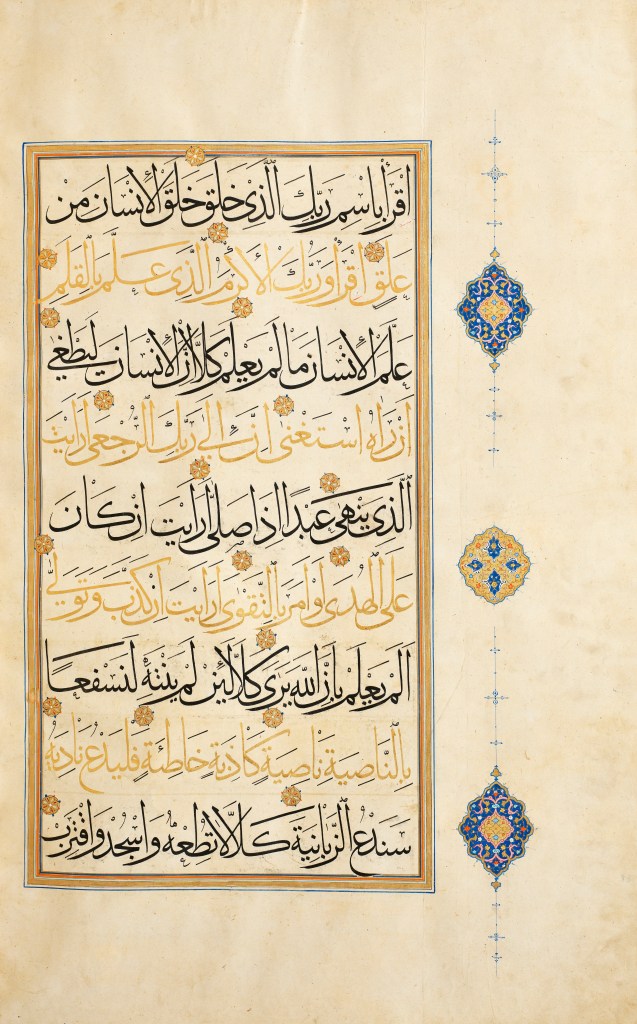
Single-volume Qu’ran, copied by Khan Ahmad Sayri. Iran, Shiraz, Safavid period, (1599). Freer Gallery of Art.
As Simon Rettig, assistant curator at the Freer-Sackler, puts it: ‘You see sixty times the same text, but with incredible variety developed by the calligrapher and illuminator.’ Sizes vary from compact to monumental. It is one of these huge Qur’ans that greets the visitor, its 543 folios weighing 60 kilos and requiring at least two people to turn the pages. Just nine lines of alternately black and gold muhaqqaq script fill each page. Made in around 1599 in Shiraz, Iran, it was endowed to a revered shrine believed to mark the grave of one of the Prophet’s companions. For the show, it is opened at the first word of the Qur’an, the instruction ‘Recite!’ – for this is the purpose of the Qur’an, not a cozy silent read in a corner. ‘Such a lavish Qur’an would be on display in a mosque,’ Rettig explains, ‘as a physical manifestation of God and also a tour de force of calligraphy. When read, the power of the word was reinforced by the huge calligraphy.’ Farhad adds that ‘its presence would be enough to give a heightened spiritual experience. I wanted to borrow this Qur’an most of all. It goes against all expectations, given the Qur’an today is mostly a small standardised printed book with a green cover.’
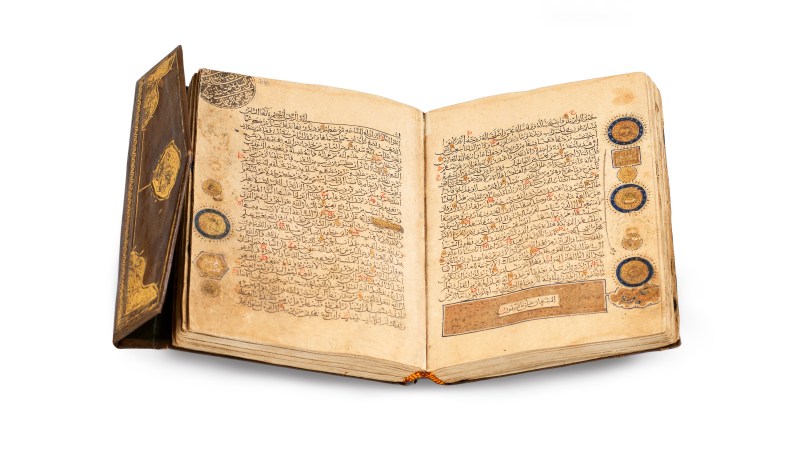
Single-volume Qur’an, copied by Abu’l-Qasim Ali ibn Abdallah ibn al-Husayn, probably eastern Iran or present-day Afghanistan, (c. 1020–30). Museum of Turkish and Islamic Arts.
Each Qur’an repays close attention. A section made in the early 8th century (and brought from Damascus’s Umayyad Mosque) has folk-like pictures of palm trees and other motifs drawn horizontally and squeezed between the suras, their designs recalling mosaics made the previous century for the Dome of the Rock in Jerusalem. One of the earliest known single-volume Qur’ans, probably made around 1020–30, was revolutionary in its use of the newly developed tight and even, flowing cursive rather than the former stiff space-hungry kufic, thus squeezing the whole text into 150 folios of just 17.5 x 12cm. At last, as Rettig says, a Muslim could carry around his ‘a deluxe pocket book’ Qur’an. Compare this with a section of a royal 30-part Qur’an made in Baghdad in 1307–08 for the Mongol ruler Uljaytu’s own mausoleum at Sultaniyya. Just five lines of elegant black-and-gold calligraphy ‘float on each page, echoing the recitation’, as Rettig puts it, and the folios are littered with fine illuminations.
Many Qur’ans have an intriguing travel story, reflecting empires’ rise and fall (some are told online, with helpful journey maps). The Sulayhi Qur’an is one, praised by Rettig as a ‘milestone’ manuscript for its fully developed thuluth script and copious, highly original illumination that includes five ‘dazzling’ opening double pages. Probably made in Cairo for the Fatimid Caliph in 1028, it may well have been taken to Sanaa as a diplomatic gift to thank the Yemeni ruler for his alliance against Baghdad. From there we know it ended up in Bursa, the first Ottoman capital, because it was from there that it arrived in Istanbul in 1913. As for Uljaytu’s prize manuscript, that was probably snapped up as war booty by the great Ottoman sultan Suleyman the Magnificent during his 1533 campaign and brought to Istanbul. An intriguing set of later seals stamped on its pages reveal that that the sultan gave it to his grand vizier who, in turn, donated it first to the tomb of Suleyman’s son and then, annoyed when the scribes altered it, took it away and gave it to a mosque supported by Suleyman’s daughter.
‘The Art of the Qur’an: Treasures from the Museum of Turkish and Islamic Arts’ is at the Freer and Sackler Galleries, Washington, D.C., from 22 October–20 February 2017.
Unlimited access from just $16 every 3 months
Subscribe to get unlimited and exclusive access to the top art stories, interviews and exhibition reviews.

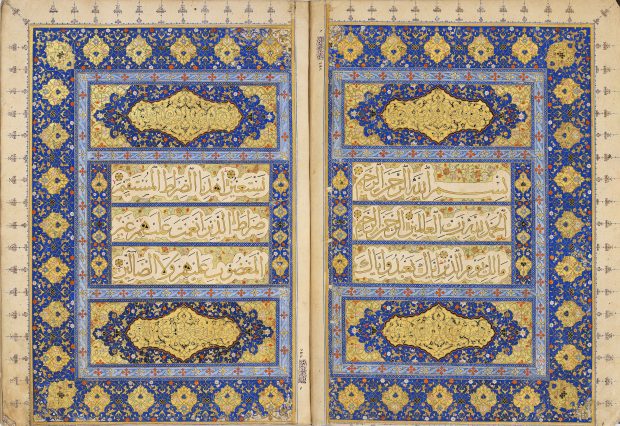
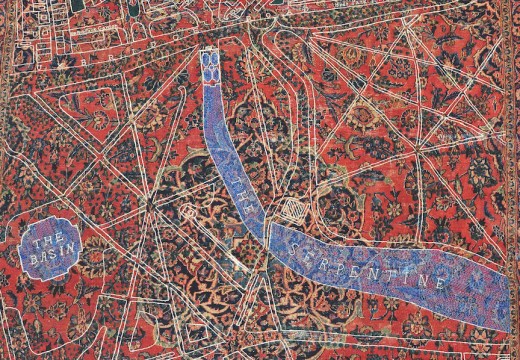
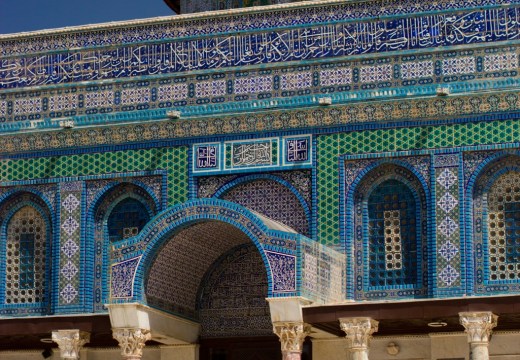
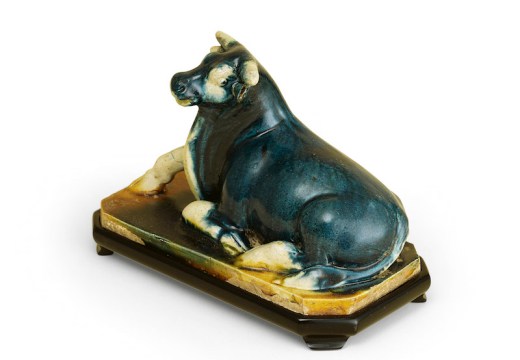









![Masterpiece [Re]discovery 2022. Photo: Ben Fisher Photography, courtesy of Masterpiece London](http://www.apollo-magazine.com/wp-content/uploads/2022/07/MPL2022_4263.jpg)
It’s time for the government of London to return to its rightful home